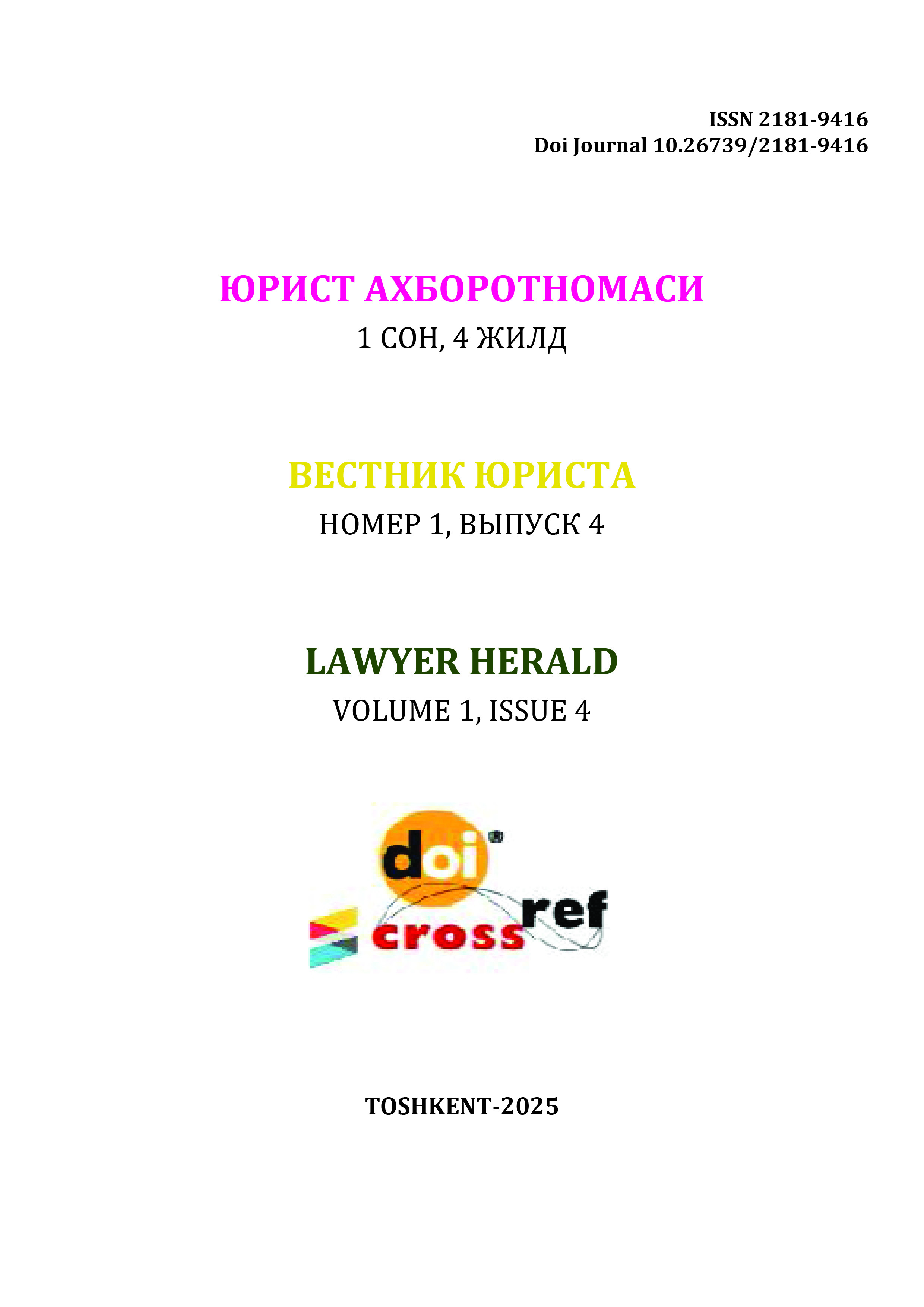Abstract
The right to a clean, healthy, and sustainable environment is recognized as a fundamental human right. Research shows that poorly implemented Environmental Impact Assessments (EIAs) can result in significant ecological and social harm. Public participation is a critical factor in improving the effectiveness of EIAs by fostering transparency, enhancing decision-making quality, and mitigating corruption risks. This article examines mechanisms to ensure the right to a sustainable environment through effective public engagement in environmental decision-making, with a specific focus on Uzbekistan. The research identifies key challenges, including low public awareness, weak enforcement mechanisms, and a lack of digital infrastructure for public participation, which collectively hinder meaningful involvement. To address these issues, the study proposes actionable recommendations, such as digitizing public engagement platforms, expanding the scope of public hearings, and fostering broader community participation. Strengthening public engagement will not only uphold the right to sustainable environment but also promote sustainable development and strengthen environmental protection efforts.
References
Preventing disease through healthy environments: a global assessment of the burden of disease from environmental risks, A Prüss-Ustün, J Wolf, C Corvalán, R Bos and M Neira, World Health Organization 2018, https://www.who.int/publications/i/item/9789241565196.
Richard K. Morgan, “Environmental Impact Assessment: The State of the Art,” Impact Assessment and Project Appraisal 30, no. 1 (March 2012): 5–14, https://doi.org/10.1080/14615517.2012.661557.
Maisarah Makmor, Hafez Salleh, and Nikmatul Adha Nordin, “Ineffective Public Participation for EIA: The Cause of Environmental Issues in Malaysia?,” Journal of Surveying, Construction & Property 11, no. 1 (June 26, 2020): 83–96, https://doi.org/10.22452/jscp.vol11no1.8.
Anne N. Glucker et al., “Public Participation in Environmental Impact Assessment: Why, Who and How?,” Environmental Impact Assessment Review 43 (November 2013): 104–11, https://doi.org/10.1016/j.eiar.2013.06.003.
André P, Enserink B, Conner D, Croal P. Public Participation International Best Practice Principles. Fargo, USA: IAIA, 2006. 3 p.
Bobir Turdiev, Enhancing Environmental Transparency in Uzbekistan: Legal Perspectives from the Aarhus Convention Framework. The American Journal of Political Science Law and Criminology, 6(11), (2024): 27–34. https://doi.org/10.37547/tajpslc/Volume06Issue11-05.
Anne Shepherd and Christi Bowler, “Beyond the Requirements: Improving Public Participation in EIA,” Journal of Environmental Planning and Management 40, no. 6 (November 1997): 725–38, https://doi.org/10.1080/09640569711877.
Okhumode Yakubu, “Delivering Environmental Justice through Environmental Impact Assessment in the United States: The Challenge of Public Participation,” Challenges 9, no. 1 (February 28, 2018): 9, https://doi.org/10.3390/challe9010009.
Mohamed Hamdhaan Zuhair and Priya A. Kurian, “Socio-Economic and Political Barriers to Public Participation in EIA: Implications for Sustainable Development in the Maldives,” Impact Assessment and Project Appraisal 34, no. 2 (April 2, 2016): 129–42, https://doi.org/10.1080/14615517.2016.1176404.
UNEP, “Assessing Environmental Impacts: A Global Review of Legislation,” 2018, https://www.unep.org/resources/assessment/assessing-environmental-impacts-global-review-legislation.
Md Arif Hasan, Kh Md Nahiduzzaman, and Adel S. Aldosary, “Public Participation in EIA: A Comparative Study of the Projects Run by Government and Non-Governmental Organizations,” Environmental Impact Assessment Review 72 (September 2018): 12–24, https://doi.org/10.1016/j.eiar.2018.05.001.
Ўзбекистон Республикаси Конституцияси, янги таҳрирда, 49-модда, 2023 йил, http://lex.uz/docs/6445145.
Ўзбекистон Республикасининг “Экологик назорат тўғрисида”ги Қонуни, ЎРҚ-363-сон, 2013 йил, 6-модда.
Ўзбекистон Республикаси Вазирлар Маҳкамасининг 2020 йил 7 сентябрдаги 541-сонли қарори. https://lex.uz/docs/4984499.
Ўзбекистон Республикасининг “Жамоатчилик назорати тўғрисида”ги Қонуни, ЎРҚ-474-сон, 2018 йил, 10-модда.
Давлат экологик экспертиза маркази маълумотлари, 2024. https://eco-service.uz/public/pages/main_about_center2?lang=uz.
Правила проведения общественных слушаний, Зарегистрирован в Министерстве юстиции Республики Казахстан, 6 августа 2021 года № 23901, https://adilet.zan.kz/rus/docs/V2100023901.
United Nations, Treaty Series , vol. 1989, p. 309. Convention on Environmental Impact Assessment in a Transboundary Context.
Lobos, Victor, and Maria Partidario. "Theory versus practice in strategic environmental assessment (SEA)." Environmental Impact Assessment Review 48 (2014): 34-46.
Gazeta.uz, O‘zbekiston doimiy aholisining etnik tarkibi e’lon qilindi, 2021, https://www.gazeta.uz/oz/2021/08/19/population/.
Bobir Turdiev, Policy Development Through Normative Legal Acts in Uzbekistan: Actors, Procedures, and Practice. International Journal of Law and Criminology, 4(11), (2024): 23–41. https://doi.org/10.37547/ijlc/Volume04Issue11-04.
Перечень действующих санитарных правил, норм и гигиенических нормативов Республики Узбекистан (СанПиН РУз), 2019 г., https://gov.uz/ru/ssv/sections/view/6381.
